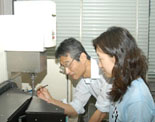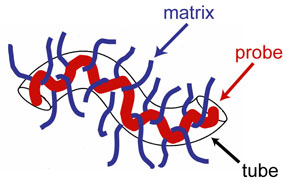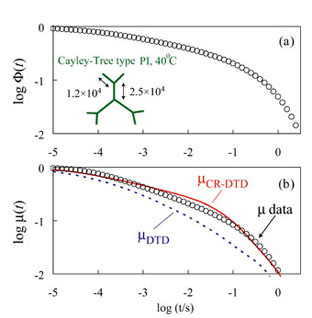Assistant Professor MATSUMIYA, Y and Professor WATANABE, H, “Dynamics of Multi-branched Polymer Chains” (Published in 2 Aug 08)
|
Assistant Professor MATSUMIYA, Yumi and Professor WATANABE, Hiroshi (Laboratory of Molecular Rheology, Division of Multidisciplinary Chemistry)
“Dynamics of Multi-branched Polymer Chains” |
 Assist Prof Matsumiya Y(left) and Prof Watanabe H(right) |
||

|
The group of Assistant Professor Yumi Matsumiya and Professor Hiroshi Watanabe, Professor Dimitris Vlassopoulos at University of Crete, and Professor Nikos Hadjichristidis has experimentally elucidated that entangled polymer chains with multi-branched structure relax through the constraint release mechanism. This result provided us with significant progress in our understanding of entanglement dynamics. | ||
 Figure 1. Schematic illustration of tube model |
The entanglement between polymer chains strongly affects the global (large scale) thermal motion of the chains governing their flow behavior. In the widely utilized tube model (cf. Figure1), the entanglement effect for a focused chain (probe) is represented by a tube along the probe backbone formed by the surrounding chains (matrix) and the probe motion is constrained in this tube. The current tube model incorporates fluctuation of the probe length measured along the tube axis as well as the removal/reformation of the tube wall resulting from motion of the tube-forming matrix chains. The probe motion activated by this wall removal/reformation, referred to as the constraint release (CR) motion, represents the motional cooperativity of the chains within the context of the mean-field tube model. | ||
| On an increase of the time scale of observation, the effective tube dilates as a result of the CR motion. The current tube model regards the relaxed portion of the chains as a simple solvent to evaluate the diameter of the dilated tube. This model describes the viscoelastic data of polymers well, but the validity of the model for the chain dynamics itself remains unclear. | |||
| For this problem, Assistant Professor Matsumiya, Professor Watanabe, and coworkers focused on a fact that the viscoelastic and dielectric relaxation functions, μ(t) and φ(t), of chains having the type-A electrical dipoles (parallel along the chain backbone) detect the same global motion with different averaging moments to formulate a relationship of these functions, μDTD(t) = {φ(t)}d + minor contribution from fluctuation at tube edge (d = 1-1.3), that should hold if the relaxed portion is equivalent to the simple solvent. They tested this relationship for a representative multi-branched chain having the type-A dipoles, a Cayley-tree cis-polyisoprene (CT-PI), to find that the above relationship does not hold for theμ(t) and φ(t) data of CT-PI and thus the relaxed portion is not equivalent to the solvent. This result demonstrated that the widely utilized, current tube model includes a flaw. Furthermore, Assistant Professor Matsumiya, Professor Watanabe, and coworkers derived the other type of μ(t)-φ(t) relationship that should hold whenever the tube dilates consistently with the CR mechanism and demonstrated its validity. This result offered an experimental basis for accurate description of the entanglement effect on the motion of multi-branched chains. |
 Figure 2. Dielectric relaxation function (a) and viscoelastic relaxation function (b) of Cayley-tree cis-polyisoprene. |
||
 Institute for Chemical Research, Kyoto University
Institute for Chemical Research, Kyoto University International Joint Usage Research Center
International Joint Usage Research Center